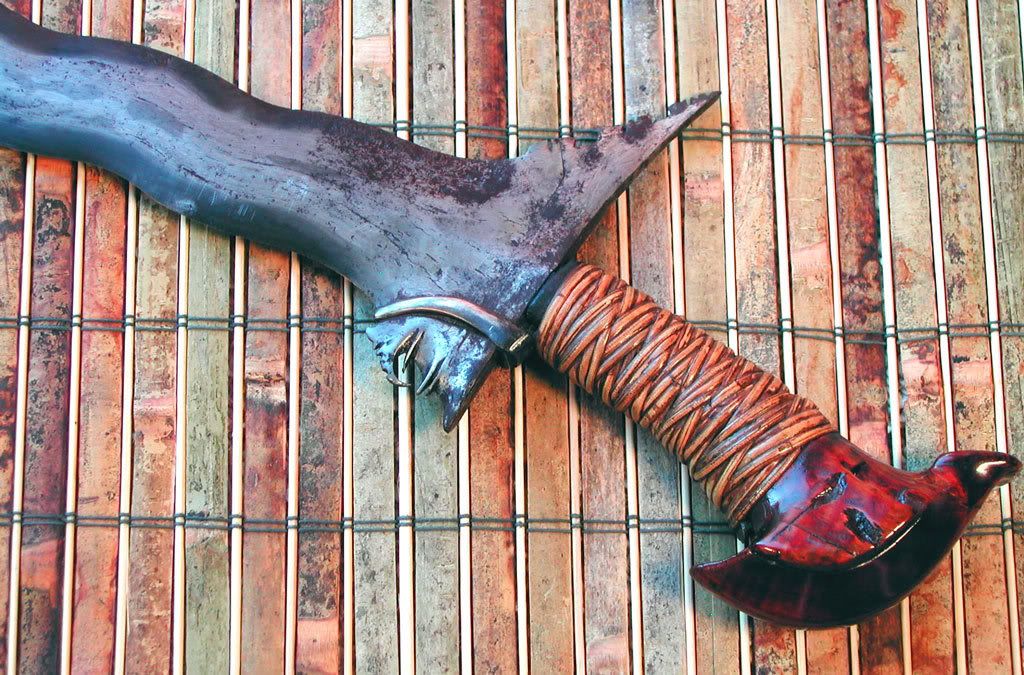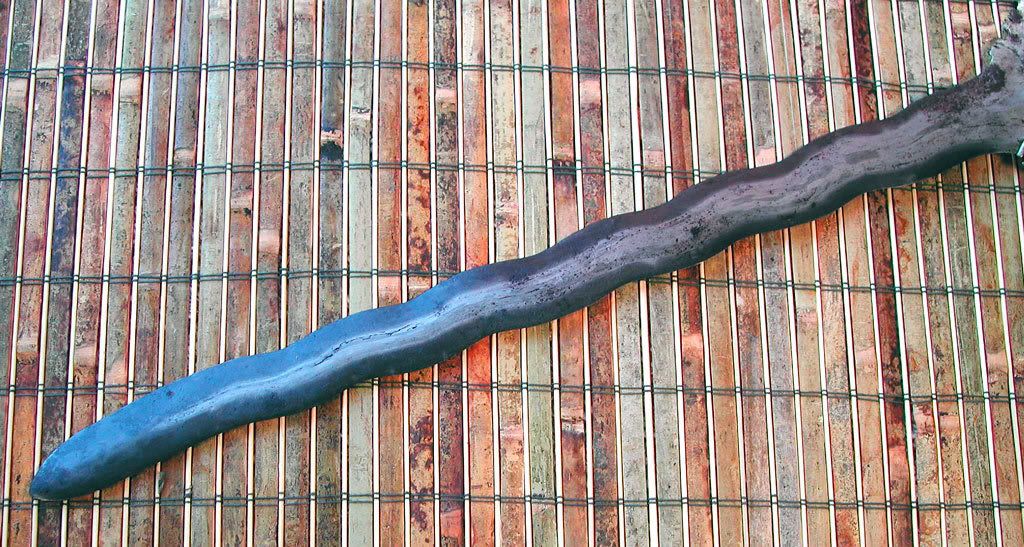
 |
|
|
#1 |
|
Member
Join Date: Dec 2004
Location: Kernersville, NC, USA
Posts: 793
|
Nothing fancy, just a good solid sundang. The blade is thinner than most I've handled. It's .150" (3.8mm) at the midpoint of the blade. Good and solid though. Looks to have been rehilted at some time. Baca baca is not original. Separate gangya. Comments welcomed.
Thanks! Steve Ferguson   
|
|
|

|
|
|
#2 |
|
Member
Join Date: Dec 2004
Location: Oahu, Hawaii
Posts: 166
|
Steve, I really like this sword, it has that solidly built common warrior look to it and judging by the size of the hilt, and the forging flaws some definate age. While I also like those that are tricked out to show status, I keep getting draw to the functional and well made as representations of the mainstream culture of the time and fior that I think you have an excellent example.
Have you thought about soaking it in vinegar- we tried that in Sulu with coconut vinegar and if there was any grain it brought it right out. We were really surprised by some that we soaked (1-3 days). Tried it at home with regular vinegar and it worked pretty good also. Dan |
|
|

|
|
|
#3 |
|
Member
Join Date: Dec 2004
Location: Kernersville, NC, USA
Posts: 793
|
Hi Dan. That's exactly how I felt, but couldn't put it into words.
 It's a commoner's sword, like an arsenal tulwar. The small hilt fits my small hand perfectly, and the hilt is very solid. The baca baca is attached to a metal strap that runs the full lenght of the hilt under the rattan. It's incredibly sharp. It's a commoner's sword, like an arsenal tulwar. The small hilt fits my small hand perfectly, and the hilt is very solid. The baca baca is attached to a metal strap that runs the full lenght of the hilt under the rattan. It's incredibly sharp. I etched with ferric chloride diluted 4:1. Do you thing vinegar would bring out something more? Would soaking in vinegar possibly soak into the forging flaws causing corrosion in the future? Thanks much for your reply! Steve |
|
|

|
|
|
#4 |
|
Vikingsword Staff
Join Date: Nov 2004
Posts: 6,339
|
Hi Ferguson,
You should be very careful with strong etchants especially on blades with cold shuts. Did you cover this blade with a baking soda paste and work it into the shuts after etching it with ferric ? Ferric needs to be totally neutralised or it will keep on eating the steel even after it's dry.  IMO this blade looks a bit burnt, i.e. too dark; kind of like an underexposed picture; a rubdown with lime juice might lighten it a bit and reveal even more activity.  Nice kris. |
|
|

|
|
|
#5 | |
|
Member
Join Date: Dec 2004
Location: Kernersville, NC, USA
Posts: 793
|
Quote:
Louieblades told me the same thing. It's a little lighter in person, but it does need lightening a bit. I'll try the lime juice. Much appreciated.  Steve |
|
|
|

|
|
|
#6 |
|
Member
Join Date: Dec 2004
Location: Italia
Posts: 1,243
|
Hi Steve, I like it!!! congratulations

|
|
|

|
|
|
#7 |
|
Member
Join Date: Dec 2004
Location: Oahu, Hawaii
Posts: 166
|
Steve in reference to question on would vinegar bring out something different. I really can't say many others here have more experience, I just knopw in Jolo the two guys I found that could tell me anything about treating the blades told me to soak them in caballa (which I later figured out is a vinegar make from coconuts) and then wipe it down with limes or star fruit. We hollowed out a large chunk of bamboo and depending on the condition of the blade after overnight to three days all corrosion and rust just fell off (actually most of it rose to the surface) and any lamination popped right out. I only used the lime after on one blade and it didn't change anything (I thought then and still do that it was redundant). after the soak the blades were left kind of chalky looking, so we used gun oil. We first tried a light coat and that was quickly (overnight) soaked up. So the next time we put on a heavy coat and that seemed to work the best leaving them with clear shiny coat that wasn still fairly dry to the touch.
I did use regular household vinegar on one of my old Lao blades when I got home and left it in too long and it opened up a lot of cracks along the lamination lines so be careful there. Dan |
|
|

|
 |
|
|